This page includes only those genes I know to be in Australia. First is a listing of each individual gene we have, followed by the colours that use that gene. Each colour is linked to a fuller description of the colour, including a photo, it’s NSW Fancy Rodent Society (NFRS) show standard (if standardised), genotype(s), and any notes regarding common faults, breeding tips, or anything else.
I have only included the more commonly-seen colours, based on what I see bred and shown in the NFRS. There are, of course, almost limitless combinations of the genes given here, and just because I haven’t included information about a lilac agouti colourpoint beige fox, doesn’t mean it doesn’t exist.
For a more complete listing of possible mouse colour genotypes and corresponding phenotypes, I have also made a publically-viewable Google document here: Mouse Genetics Table.
Reference Table
| A(y) |
Lethal Yellow |
Fawn, Ginger, Sable, Black-Eyed White, Cream, Silver Sable, Cream Sable, Straw |
| A(vy) |
Viable Yellow |
Brindle, Snowtiger, Cream Brindle |
| A |
Agouti |
Agouti, Argente, Cinnamon, Apricot, Blue Agouti, Blue Argente, Chinchilla, Silver Agouti, Argente Cream, Agouti Burmese, Bone Agouti |
| a(t) |
Tan |
Tan, Fox |
| a |
Non-Agouti |
Black, Dove, Chocolate, Champagne, Blue, Silver, Lilac, Lavender, Havana, Mock-Chocolate, Coffee, Bone, Siamese, Himalayan, Burmese, Colourpoint Beige |
| C |
Non-Diluted |
|
| c |
Albino |
Pink-Eyed White, Himalayan, Bone, Mock-Chocolate, Chinchilla, Argente Cream |
| c(h) |
Himalayan |
Siamese, Burmese, Himalayan, Colourpoint Beige, Agouti Siamese, Agouti Burmese |
| c(ch) |
Chinchilla |
Chinchilla, Silver Agouti, Argente Cream, Havana, Mock-Chocolate, Cream, Cream Sable, Cream Brindle |
| c(e) |
Extreme Dilute |
Coffee, Reverse Siamese, Bone, Mock-Chocolate, BEW, Silver Sable, Snowtiger |
Top
Black

- Phenotype
- Non-agouti
- Genotype
- aa
- Standard
- A deep lustrous black with no flecking or rusting. Eyes black.
- Notes
- It’s quite common to see white or grey ticking on the flanks of Black mice, this is a fault. A good quality Black is often used as an outcross to darken diluted colours, because it’s easier to see if the mouse has any white flecking or greying on a Black background.
Top
Dove
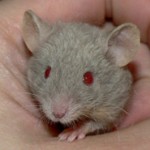
- Phenotype
- Pink-eyed non-agouti
- Genotype
- aa pp
- Standard
- A warm soft grey, distinguished from silver by its warmth. Eyes pink.
- Notes
- Dove is quite variable, ranging from anything from pale silver to a medium bluey or browny colour. Somewhere in the middle is more desirable. Tends towards a white nose – this is a fault.
Top
Chocolate

- Phenotype
- Chocolate-diluted non-agouti
- Genotype
- aa bb
- Standard
- A mid chocolate brown colour, resembling milk chocolate, with no hint of red or ginger. Eyes black.
- Notes
- Not as rich as the cordovan brown of international mice, more a cool dirt-brown. This colour also suffers from obvious white ticking. The chocolate gene often creates false ruby eyes, as it can dilute the eyes slightly.
Top
Champagne
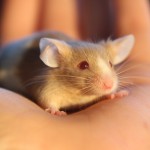
- Phenotype
- Pink-eyed chocolate-diluted non-agouti
- Genotype
- aa bb pp
- Standard
- A warm, creamy yellow. Eyes pink.
- Notes
- Much richer and warmer than Dove. The chocolate gene often creates false ruby eyes, as it can dilute the eyes slightly.
Top
Blue

- Phenotype
- Blue-diluted non-agouti
- Genotype
- aa dd
- Standard
- A medium slate blue. Colour should resemble the blue colour found in cats. Eyes black.
- Notes
- A popular colour in the fancy. Adds a lovely cool shade to any colour or marking. Blues often suffer from “heathering”, making the coat colour uneven with an almost ticked appearance. Use good quality Black outcrosses to darken and smooth the colour.
Top
Silver
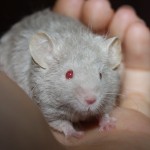
- Phenotype
- Pink-eyed blue-diluted non-agouti
- Genotype
- aa dd pp
- Standard
- A pale, ice blue, with no hint of browning. Eyes pink.
- Notes
- A lovely bright, icy blue – distinguishable from Lavender by the cool hues and richness of colour. Cross to a blueish Dove to improve the colour.
Top
Lilac

- Phenotype
- Chocolate-dilute blue-diluted non-agouti
- Genotype
- aa bb dd
- Standard
- A dark metallic silver, neither too blue nor too brown. Eyes black.
- Notes
- Colour should be right in between Blue and Chocolate. Comparing side-by-side to a Blue and Chocolate mouse will be the best judge. Suffers from heathering as Blue does – a good quality Black outcross will improve the colour here too.
Top
Lavender
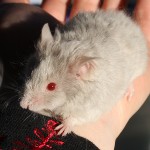
- Phenotype
- Pink-eyed chocolate-dilute blue-diluted non-agouti
- Genotype
- aa bb dd pp
- Standard
- Unstandardised.
- Notes
- A pale creamy colour, not too grey nor too brown. Paler than Silver, and almost pinkish in hue.
Top
Siamese
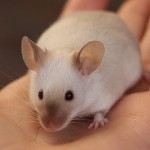
- Phenotype
- Himalayan non-agouti
- Genotype
- aa c(h)c(h)
- Standard
- The coat is to be warm beige over the entire body, shading to a deeper colour on the hindquarters.
The colours should blend gradually. Points should be a rich chocolate colour, or as dark as possible,
and they should be well defined on the muzzle, and well confined to the whisker, muzzle, rump, tail, ears and feet areas.
- Notes
- A popular colour. Quality of points and presence of shading varies greatly. Select the darkest points and best shading to breed from, and outcross to nice dark Blacks or Chocolates to darken (though keep in mind a chocolate-based Siamese will not be as dark as a black-based Siamese). Males tends to be nicer, and points and shading will improve with age. Points are temperature-dependant, so babies raised in cooler months will theoretically have better points. Eyes are ruby.
Top
Himalayan
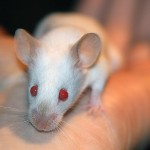
- Phenotype
- Himalayan / Albino (heterozygous) non-agouti
- Genotype
- aa c(h)c
- Standard
- The coat is to be as white as possible in colour over the entire body, with well defined points. Points are to be a light milk chocolate, and should conform to the Siamese standard in regards to size and placement, with no shading. Eyes pink or ruby.
- Notes
- As with Siamese, except there is no shading. Body should be near-white, too dark and creamy would be considered a fault.
Top
Burmese
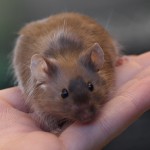
- Phenotype
- Himalayan / Chinchilla (heterozygous) non-agouti
- Genotype
- aa c(h)c(ch)
- Standard
- The coat is to be a dark, rich chocolate. The points are to be as dark as possible, almost black. Points should conform to the Siamese standard in regards to size and placement, with no shading.
Eyes black.
- Notes
- As with Siamese, same outcrosses. Points are sadly often poor. Burmese are also more difficult to breed consistently than Siamese, being heterozygous. Blue Burmese is a particularly pretty colour.
Top
Colourpoint Beige
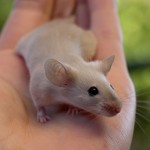
- Phenotype
- Himalayan / Extreme-diluted (heterozygous) non-agouti
- Genotype
- aa c(h)c(e)
- Standard
- The coat is to be a soft, light brown, similar to milked coffee. The points are to be a medium brown, or as dark as possible. Points should conform to the Siamese standard in regards to size and placement, with no shading. Eyes black.
- Notes
- As with Siamese, same outcrosses. Blue Colourpoint Beige (aka Colourpoint Blue, Colourpoint Smoke) is a particularly pretty colour.
Top
Reverse Siamese

- Phenotype
- Extreme-diluted non-agouti
- Genotype
- aa c(e)c(e)
- Standard
- The coat is to be a medium brown, with the points a bright white, and conform to the Siamese standard in regards to size and placement, with no shading. Eyes black.
- Notes
- There is still a lot of conjecture regarding the genotype of the Reverse Siamese. I have bred quite a few of these over the years and feel pretty strongly that it is a result of the same genes that produce Coffee, with Coffee being produced by selecting away from the point, and Reverse by selecting for the point. If there was a single dominant modifier creating Reverse Siamese, for example Umbrous, then we would be seeing litters of Reverses where some have Umbrous and some do not, ie. both Coffee and Reverse in the same litter – and I have never seen this happen. Another interesting interaction is that the c(e) gene seems to express *darker* when exposed to the Chocolate gene. So, a Chocolate Reverse Siamese is darker than a black-based one.
Top
Havana
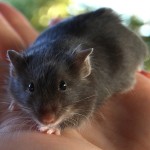
- Phenotype
- Chinchillated non-agouti
- Genotype
- aa c(ch)c(ch)
- Standard
- A rich, deep brown, almost black, which resembles unmilked coffee. Eyes black.
- Notes
- Often confused with Black (it is so dark that it should appear nearly Black), this colour has a distinctly warm hue. Some Blacks appear faded or greyed out – this is not Havana, more likely that the mouse is carrying dilutes that are affecting the colour. Due to the presence of the Chinchilla genes, it is impossible to have a Havana Tan – they would be Foxes.
Top
Mock-Chocolate

- Phenotype
- Chinchillated / Albino (heterozygous) OR Chinchillated / Extreme-diluted (heterozygous) non-agouti
- Genotype
- aa c(ch)c OR aa c(ch)c(e)
- Standard
- Unstandardised.
- Notes
- There are two versions of Mock-Chocolate, one with the Albino gene and one with the Extreme-Dilute gene. Both versions can be further diluted by other colours, like Blue. Blue Mock-Chocolate is an attractive colour not unlike Blue Burmese. Mock-Chocolates often show ‘false points’.
Top
Coffee

- Phenotype
- Extreme-diluted non-agouti
- Genotype
- aa c(e)c(e)
- Standard
- A warm, medium brown colour, similar to milked coffee. Eyes black.
- Notes
- An uncommon colour these days. Most examples of c(e)c(e) around at the moment express as Reverse Siamese. If the current theory is correct, then one could produce a Coffee mouse by selecting for less and less point in Reverse lines.
Top
Bone

- Phenotype
- Extreme-diluted / Albino (heterozygous) non-agouti
- Genotype
- aa c(e)c
- Standard
- A light, warm grey colour. Eyes black.
- Notes
- Phenotypically very similar to Silver Sable (Extreme-Diluted Sable), except without the obesity problems. This colour is extremely variable, with some bones nearly white and some nearly as dark as a Reverse Siamese. Bones tend to suffer from a pale nose, this should be selected away from.
Top
Pink-Eyed White

- Phenotype
- Albino
- Genotype
- cc
- Standard
- A snow white, with no hint of flecking, ticking or lemon spotting. Eyes pink or black.
- Notes
- Most PEWs are albinos, but there are other genotypes possible so as to appear PEW – such as A(y) c(ch)c(ch) pp, or A(y) c(h)c. An albino PEW is one of the easiest colours to breed and show, though a common fault is yellowing, especially around the rump and groin region of males – washing regularly with a bluing shampoo will keep the coat at its best. Albinos (and other pink-eyed mice) tend to suffer from small eyes.
Top
Agouti
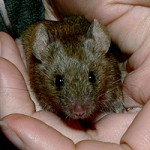
- Phenotype
- Agouti
- Genotype
- A*
- Standard
- The coat is to have an overall rich, chestnut brown colour, with dark slate undercoat. There will be black ticking throughout the coat, with black guard hairs, extending over the entire body, including the feet, with the belly being silver-grey. Eyes black.
- Notes
- Wildtype. Characterised by both Black and Fawn hairs, tipping and banding. Young mice tend to be duller and greyer, the Fawn ticking doesn’t brighten to standard until the adult coat comes through. A common fault is too much Black down the spine of the mouse. This fault is mirrored in all ticked colours. Beware of crossing Agoutis to mice from Sable lines, the Umbrous gene present in this colour will only serve to darken the spine even more.
Top
Argente
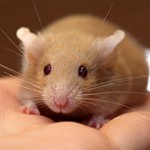
- Phenotype
- Pink-eyed agouti
- Genotype
- A* pp
- Standard
- The coat is to be a warm, rich orange, with dove grey undercoat. There will be grey ticking throughout the coat, with grey guard hairs, and the belly being silvery. Eyes pink.
- Notes
- The Black hairs are diluted to Dove, the Fawn hairs are undiluted. Distinguishable from Apricot by its richer, deeper colour. Common faults are a dull or washed-out colour and too much Dove ticking down the spine. Dove and Fawn hairs should be evenly mixed over the whole body. Crossing to any colour where Fawn is present and bright/clear will help the brightness of this colour.
Top
Cinnamon
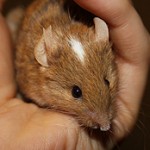
- Phenotype
- Chocolate-diluted agouti
- Genotype
- A* bb
- Standard
- As for Agouti, with gold tan substituting for the rich brown and ticking and undercoat to be of a chocolate brown colour, with the belly colour being a warm mid grey. Eyes black.
- Notes
- The Black hairs are diluted to Chocolate, the Fawn hairs are undiluted. Similar to Agouti in all but the overall colour is much warmer and browner – some call this colour Golden Agouti. It suffers from the same faults. Crossing to a Black or Chocolate with no white ticking will help the Chocolate quality.
Top
Apricot
- Phenotype
- Pink-eyed chocolate-diluted agouti
- Genotype
- A* bb pp
- Standard
- As for Argente, but with a bright creamy undercoat colour, giving a brighter, fresher appearance. The belly colour is a creamy silver. Eyes pink.
- Notes
- The Black hairs are diluted to Champagne, the Fawn hairs are undiluted. The overall appearance of this colour is brighter and clearer than Argente, and slightly paler and creamier. Otherwise suffers from the same faults.
Top
Blue Agouti

- Phenotype
- Blue-diluted agouti
- Genotype
- A* dd
- Standard
- The coat is to have an overall soft straw colour, with steel blue undercoat and blue ticking
throughout. The belly is a cool silver. Eyes black.
- Notes
- Sometimes called Opal. The Black hairs are diluted to Blue, the Fawn hairs are diluted to Straw. Quite a variable colour, this seems to range from an overall steely blue appearance right through to the pale orange of Straw. Heavily affected by how much Black/Fawn hairs/tipping is present in the coat, therefore it is important to start with a good, strong Agouti to get an even mixing of Blue and Straw.
Top
Blue Argente
- Phenotype
- Pink-eyed blue-diluted agouti
- Genotype
- A* dd pp
- Standard
- Unstandardised.
- Notes
- Sometimes mistakenly called Silver Agouti (which is a c-dilute colour), referring to Silver, pink-eyed Blue. The Black hairs are diluted to Silver, the Fawn hairs are diluted to Straw. Somewhat similar to Argente, the giveaway should be the paler straw colour of the fawn hairs, and the cooler undertones of the Silver.
Top
Chinchilla
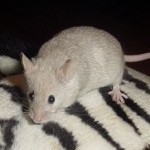
- Phenotype
- Chinchillated agouti
- Genotype
- A* c(ch)c OR A* c(ch)c(e)
- Standard
- The coat is to have a pearl-gray background, evenly tipped with black, and a slate blue base to the hairs. The belly and the inside of the legs is to be silver-white, the outside of the legs to match the top color. Eyes black.
- Notes
- The Black hairs are diluted to Mock-Chocolate, the Fawn hairs are diluted to white. As with Mock-Chocolate, this comes in 2 shades. The standard calls for black tipping, but in reality this isn’t possible. The darkest the tips on a Chinchilla hair can be are Mock-Chocolate. The best we can do is cross to a heavily-ticked Agouti, maximising the contrast.
Top
Silver Agouti

- Phenotype
- Chinchillated agouti
- Genotype
- A* c(ch)c(ch)
- Standard
- As for Agouti, but where golden brown would be expected substitute silver grey with a base colour of dark slate grey. The ticking is still to be black, with the belly colour to range from silver grey to dark slate grey. Eyes black.
- Notes
- The Black hairs are diluted to Havana, the Fawn hairs are diluted to white. This is perhaps closer to the overseas standards of Chinchilla, from which our own standards originate. A striking, high-contrast colour.
Top
Argente Cream

- Phenotype
- Pink-eyed chinchillated agouti
- Genotype
- A* c(ch)c(ch) pp
- Standard
- The coat is to be a delicate blend of a pale, creamy orange and silver, with the undercoat an extremely pale silvery white. The belly and the inside of the legs is to be white, the outside of the legs to match the top colour. Eyes pink.
- Notes
- The Black hairs are diluted to white, the Fawn hairs are diluted to a creamy orange (pink-eyed Havana). Due to the linking of the C and P loci, this colour is impossible in practice to breed from a black-eyed line, you must start with a line that already has Argente Cream (or pink-eyed Havana, etc) present. This colour suffers heavily from the Black-hairs clumping at the spine, displaying as a nearly white back, and orange showing only at the tail base and face. Outcrosses to very even, or Fawn-heavy ticked mice can useful.
Top
Bone Agouti
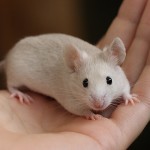
- Phenotype
- Extreme-diluted / Albino (heterozygous) agouti
- Genotype
- A* c(e)c
- Standard
- Unstandardised.
- Notes
- The Black hairs are diluted to Bone, the Fawn hairs are diluted to white. Overall phenotype similar to a regular bone, but a little paler, with subtle grey-on-white ticking. As with Bone, this colour suffers from a pale nose – the colour should go right down to the whisker-bed if possible.
Top
Agouti Burmese
- Phenotype
- Himalayan / Chinchilla (heterozygous) agouti
- Genotype
- A* c(h)c(ch)
- Standard
- Unstandardised.
- Notes
- The Black hairs are Burmese, the Fawn hairs are white. Phenotypically similar to Silver Agouti, but with a darker nose point and slightly lighter body colour.
Top
Fawn
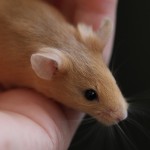
- Phenotype
- Lethal yellow
- Genotype
- A(y)*
- Standard
- A warm shade of deep orange, distinguished from ginger by its richness. Eyes pink or black.
- Notes
- To breed nice, bright Fawns, stay away from Sable and Brindle mice as these will dirty your lines. The Fawn gene is linked to obesity in mice, so selecting for slimmer animals is important. Keep in mind when breeding A(y) mice that 2 copies of the A(y) gene is lethal – that is, any A(y)A(y) babies produced will be reabsorbed before birth. This can cause Fawn x Fawn litter sizes to be smaller. Also note that the current standard calls for either pink or black eyes, but pink-eyed Fawn is better known as Ginger.
Top
Ginger

- Phenotype
- Pink-eyed lethal yellow
- Genotype
- A(y)* pp
- Standard
- A vivid, bright orange. Eyes pink or black.
- Notes
- Ginger should be brighter and more vibrant than Fawn. The Fawn gene is linked to obesity in mice, so selecting for slimmer animals is important. Also note that the current standard calls for either pink or black eyes, but black-eyed Ginger is better known as Fawn.
Top
Straw

- Phenotype
- Blue-diluted lethal yellow
- Genotype
- A(y)* dd
- Standard
- Unstandardised.
- Notes
- This very pretty colour is more often seen as part of Blue Agouti and is actually quite uncommon as its own colour.
Top
Black-Eyed White

- Phenotype
- Extreme-diluted lethal yellow
- Genotype
- A(y)* c(e)c(e)
- Standard
- A snow white, with no hint of flecking, ticking or lemon spotting. Eyes pink or black.
- Notes
- Other genotypes possible, for example A(y)* c(h)c(h) would appear as a Black-Eyed White, because the Himalayan gene also dilutes fawn hairs to white. This phenotype can also be achieved with a marked mouse where the body is 100% white marking.
Top
Cream
- Phenotype
- Chinchillated lethal yellow
- Genotype
- A(y)* c(ch)c(ch)
- Standard
- A very pale cream, to resemble off-white and to have no yellow tinge. Eyes pink or black.
- Notes
- Other genotypes possible. Worth noting that the vast majority of Cream mice will have black eyes – pink-eyed true Cream mice are as rare as Argente Cream mice, and created in the same way – the breaking and re-linking of the C and P loci.
Top
Sable

- Phenotype
- Umbrous lethal yellow
- Genotype
- A(y)* U*
- Standard
- Sable mice are to be a rich dark brown on the back, extending from the tip of the nose to the base of the tail, with the belly colour ia rich tan, as golden as possible. The shading is to be gradual, extending down the sides of the animal with no lines of demarcation. Eyes black.
- Notes
- The Fawn gene is linked to obesity in mice, so selecting for slimmer animals is important.
Top
Silver Sable
- Phenotype
- Extreme-diluted umbrous lethal yellow
- Genotype
- A(y)* U* c(e)c(e)
- Standard
- Unstandardised.
- Notes
- Sometimes called Marten Sable. The fawn base is White, the black shading is Coffee. Other genotypes possible – see Snowtiger.
Top
Cream Sable
- Phenotype
- Chinchillated umbrous lethal yellow
- Genotype
- A(y)* U* c(ch)c(ch)
- Standard
- Unstandardised.
- Notes
- The fawn base is Cream, the black shading is Havana. Other genotypes possible – see Cream Brindle.
Top
Brindle
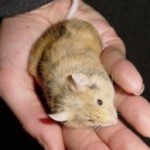
- Phenotype
- Viable yellow
- Genotype
- A(vy)*
- Standard
- Brindled mice are to have tiger striping that extends from the nose to the tip of the tail, including the feet and ears, and to a lesser extent, the belly. A “W” or “M” marking on the forehead is desirable.
- Notes
- The Brindle gene is linked to obesity in mice, so selecting for slimmer animals is important.
Top
Snowtiger

- Phenotype
- Extreme-diluted viable yellow
- Genotype
- A(vy)* c(e)c(e)
- Standard
- Brindled mice are to have tiger striping that extends from the nose to the tip of the tail, including the feet and ears, and to a lesser extent, the belly. A “W” or “M” marking on the forehead is desirable.
- Notes
- The fawn base is White, the black stripes are Coffee. Other genotypes possible – you can make a Snowtiger by applying any C-dilute colour to a Brindle, though the darker colours will produce better contrast.
Top
Cream Brindle
- Phenotype
- Chinchillated viable yellow
- Genotype
- A(vy)* c(ch)c(ch)
- Standard
- Brindled mice are to have tiger striping that extends from the nose to the tip of the tail, including the feet and ears, and to a lesser extent, the belly. A “W” or “M” marking on the forehead is desirable.
- Notes
- Sometimes considered a variety of Snowtiger. The fawn base is Cream, the black stripes are Havana. Chinchillated brindles have the darkest stripes possible for a Snowtiger, but the base is Cream instead of White, so the contrast is not as good overall.
Top
































